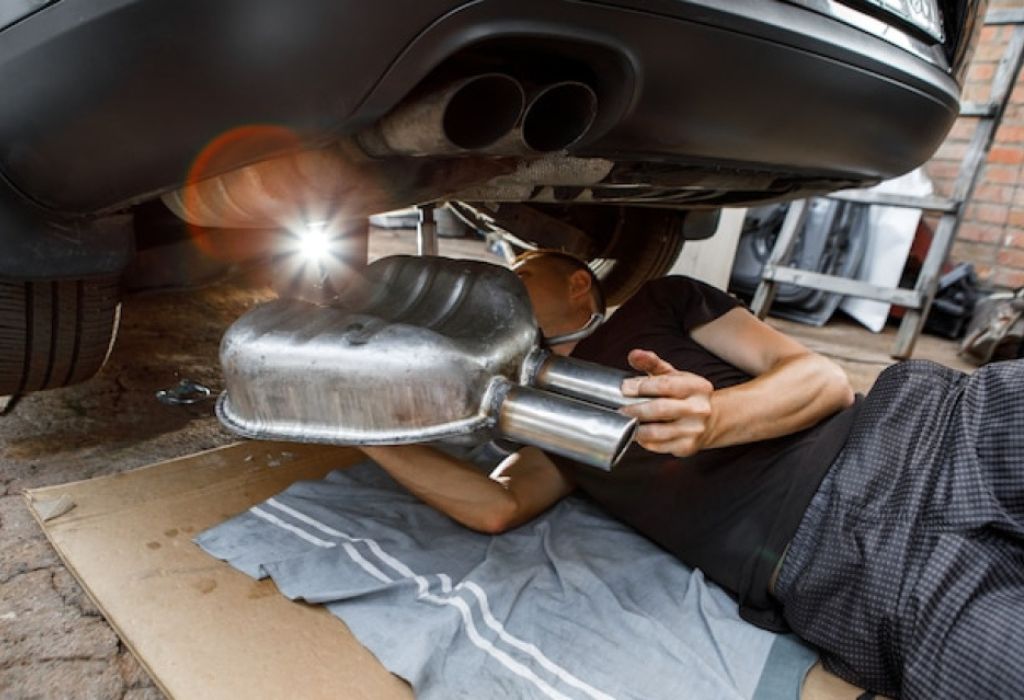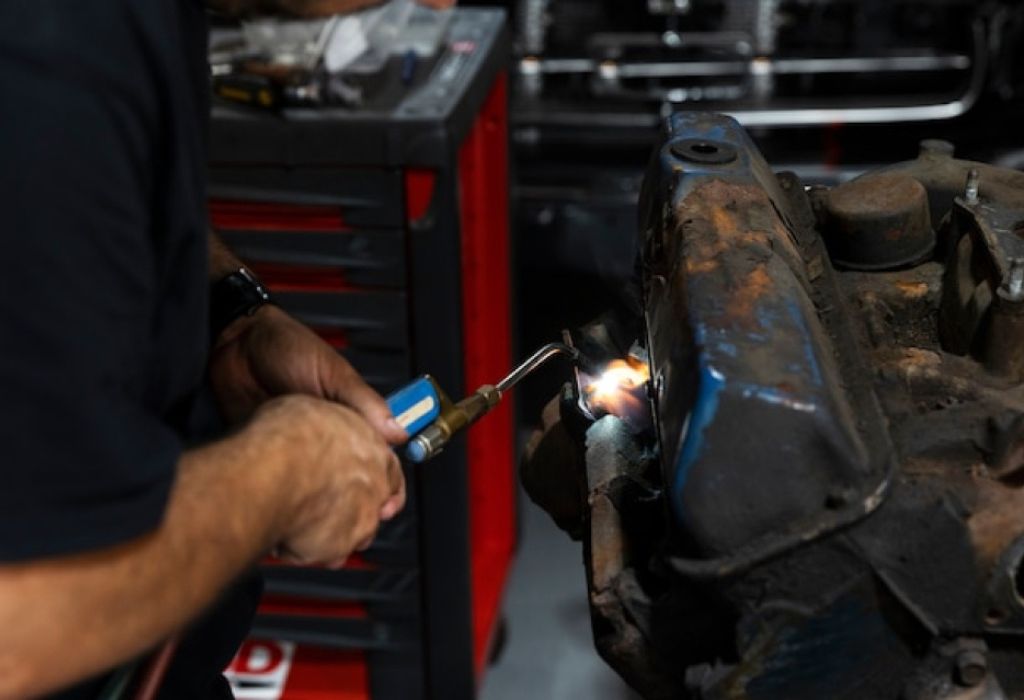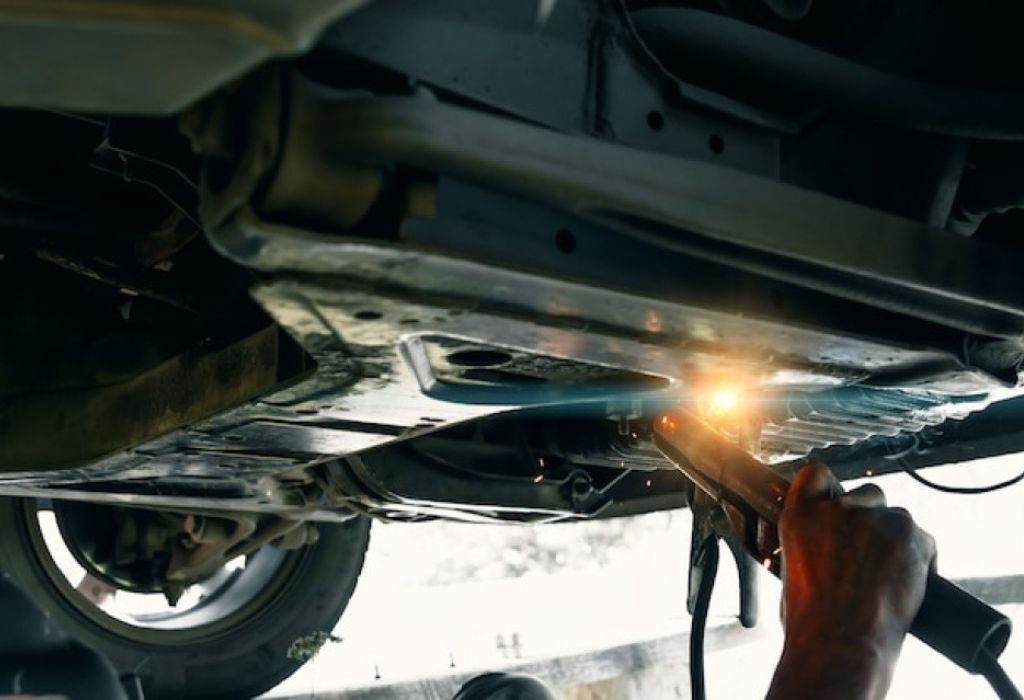A small exhaust leak may not seem like a big deal at first, but over time it can turn into a loud, fume-filled problem that affects performance and safety. Many car owners try to fix it with quick clamps or sealants, only to see the issue return weeks later.
The real solution lies in learning how to MIG weld exhaust pipe on car properly, ensuring a strong, leak-free connection that can handle heat, vibration, and corrosion. This skill not only restores quiet operation but also improves overall vehicle efficiency.
Welding exhaust pipes is challenging because of their thin metal structure. Even a slight increase in heat can cause burn-through, while too little heat leaves weak joints that crack under pressure. It’s a balance that requires patience, preparation, and the right welding technique.
According to CarMD’s Vehicle Health Index, exhaust and emissions issues account for nearly 15% of all check-engine light problems, often caused by leaks or improper repairs. With proper MIG welding methods, these failures can be significantly reduced.
Understanding the correct voltage, wire speed, and gas mix can make the difference between a smooth weld and a noisy disaster. Using a controlled stitch-welding technique helps manage heat and avoid distortion.
Why Learn How to MIG Weld Exhaust Pipe on Car

Every vehicle’s exhaust system plays a crucial role in managing emissions, noise, and performance. When a pipe cracks or leaks, it doesn’t just sound bad—it can cause reduced fuel efficiency, engine misfires, and even harmful gas exposure inside the cabin.
Knowing how to MIG weld exhaust pipe on car ensures that repairs are strong, durable, and resistant to vibration and corrosion. Unlike temporary fixes, a proper weld restores the pipe’s structural integrity and maintains consistent backpressure for smooth engine function.
Exhaust pipes are often made from thin metal such as mild or stainless steel, which can easily warp or burn through if too much heat is applied. MIG welding provides excellent control over heat input, making it the preferred method for precision and clean finishes.
Learning this skill also saves significant repair costs over time. Professional exhaust welding jobs can cost anywhere between $100 to $300 per joint, while mastering this technique allows car enthusiasts to make reliable repairs themselves.
why can’t exhaust leaks just be sealed with clamps or paste?
Sealing compounds or clamps provide only a short-term fix. High temperatures and vibration eventually break them down, leading to recurring leaks.
what happens if exhaust leaks are left untreated?
Leaks can let carbon monoxide enter the cabin, reduce engine performance, and cause vehicles to fail emissions tests.
why is MIG welding better for exhaust pipes than TIG or Stick?
MIG welding offers faster operation, consistent bead control, and better adaptability for thin materials found in exhaust pipes.
does a well-done exhaust weld improve performance?
Yes. A smooth, airtight weld maintains proper exhaust flow, improves backpressure balance, and enhances fuel efficiency.
how difficult is it to learn MIG welding for exhaust repairs?
With the right equipment, settings, and practice, even beginners can achieve professional-quality welds in a short time.
Tools, Materials, and Workspace Setup for How to MIG Weld Exhaust Pipe on Car
Before starting any weld, preparation and setup are the foundation of success. Having the right tools and materials ensures clean joints, steady performance, and safety throughout the process. Welding exhaust pipes involves thin metals that can burn through easily, so every setup detail matters.
A MIG welder with adjustable voltage and wire speed is essential. For exhaust pipes, a machine capable of operating at low amperage (around 30–140 A) provides precise control.
The recommended wire is ER70S-6 with a diameter of 0.023–0.030 inch, paired with a 75% argon / 25% CO₂ shielding gas mix for smooth, spatter-free welds.
The workspace should have solid ventilation, bright lighting, and a stable work surface. Clamps or magnetic holders help keep the pipe aligned during welding, while a grinder or wire brush removes paint and rust for a clean base. Always keep a fire extinguisher nearby and wear proper protective gear.
what MIG welder specs are ideal for exhaust pipe repair?
A welder with a low amperage range and adjustable controls allows you to fine-tune voltage and feed rate to prevent burn-through.
what wire and gas mix should be used for clean results?
Use ER70S-6 wire with a 75/25 argon-CO₂ mix to reduce spatter and achieve even penetration.
how should the pipes be prepared before welding?
Clean both ends thoroughly with a grinder or wire brush to remove any contaminants, rust, or coatings that could cause porosity.
why is workspace ventilation important during exhaust welding?
Exhaust components often have coatings that release toxic fumes when heated; ventilation protects against inhalation hazards.
what safety items should be worn when MIG welding under a car?
Wear a welding helmet, gloves, safety glasses, heat-resistant jacket, and closed-toe boots, ensuring full protection from sparks and fumes.
Preparation: Cleaning, Fit-Up, and Welder Settings for How to MIG Weld Exhaust Pipe on Car
Proper preparation determines the quality and longevity of your weld. Exhaust pipes are thin, often corroded, and exposed to constant vibration, so the smallest flaw during prep can lead to cracks or leaks later. Before striking an arc, every surface, joint, and machine setting must be precise.
Start by cleaning the pipe thoroughly. Remove all rust, paint, dirt, or grease using a grinder, sandpaper, or wire brush. Any contamination can cause porosity or uneven weld beads.
After cleaning, check the pipe alignment—poor fit-up will force you to use excessive heat, which risks burn-through and distortion.
The gap between pipes should be minimal, typically equal to the metal’s thickness (around 1–1.5 mm). Secure both ends using clamps or magnets to avoid movement while welding.
This ensures consistent contact and prevents vibration-induced cracking once the system heats and cools.
Adjust your welder for thin metal work. Lower voltage settings (15–18 V) and slower wire feed speed are ideal.
Keep a short stick-out (around 10 mm) and maintain stable gas flow at 20–25 CFH for clean shielding coverage. Always test your settings on scrap metal of similar thickness before working on the actual exhaust pipe.
why must exhaust pipes be cleaned before welding?
Contaminants such as rust, grease, or paint cause weak spots, poor penetration, and gas bubbles inside the weld bead.
what is fit-up and why is it critical in exhaust welding?
Fit-up ensures the pipe edges are properly aligned. Uneven gaps cause excessive heat input, warping, or incomplete fusion.
how wide should the joint gap be between two pipes?
A gap of about 1–1.5 mm, roughly equal to the pipe wall thickness, provides enough space for full penetration without burning through.
how can welder settings affect the final weld quality?
Incorrect voltage or wire speed can lead to spatter, lack of fusion, or holes in the metal. Proper calibration ensures stability and control.
why should test welds be done on scrap metal first?
Testing on similar material allows fine-tuning of heat and feed settings, preventing costly mistakes on the real exhaust system.
Step-by-Step: How to MIG Weld Exhaust Pipe on Car for Smooth Finish

Welding an exhaust pipe requires patience, control, and the right sequence. Since exhaust tubing is thin and heat-sensitive, using a systematic approach ensures clean, smooth welds that don’t crack or leak. Following each step carefully will help maintain consistent quality from start to finish.
Begin with tack welds to secure the pipe in position. Place small tacks around the joint every few inches to prevent movement or misalignment.
Once tacked, use short, controlled welds known as stitch welds. These allow the metal to cool between passes, preventing distortion and burn-through.
Keep the MIG gun at a 10–15° push angle, holding a stick-out distance of around 3/8 inch. Move steadily along the joint while maintaining even wire feed and travel speed.
Avoid pausing too long in one spot, as it can create holes or weak areas. After completing the bead, let the metal cool slowly and inspect for pinholes or uneven spots.
Grind off excess spatter with a flap disc for a polished finish. Finally, apply a high-temperature anti-corrosion coating or paint to protect the weld from rust and moisture exposure.
what is a tack weld and why is it important for exhaust repair?
Tack welds hold the pipe securely before the final weld, preventing shifting or misalignment during the welding process.
how does stitch welding help when working on thin exhaust pipes?
Stitch welding breaks the weld into short segments, allowing heat to dissipate and reducing the risk of burn-through.
what is the correct MIG gun angle for a clean bead?
A push angle of 10–15° offers better visibility, smoother penetration, and less spatter than a pull technique.
how can overheating be prevented during the welding process?
Move continuously, use lower voltage, and let the metal cool between passes to maintain temperature control.
what should be done after the final weld is completed?
Allow the pipe to cool gradually, inspect the weld for gaps or cracks, grind any rough areas, and coat it with anti-rust spray for protection.
Tips for Beginners on How to MIG Weld Exhaust Pipe on Car
For beginners, MIG welding an exhaust pipe can seem intimidating, especially when dealing with thin, heat-sensitive metal.
However, with the right approach, even first-time welders can create strong, smooth, and professional-looking joints. The key is practice, patience, and mastering control over heat and movement.
Start by practicing on scrap tubing of the same thickness as your exhaust pipe. This helps you learn how the metal reacts to heat and how to balance wire feed with voltage.
Focus on building consistent weld beads before moving on to the actual car. Short weld bursts, steady travel speed, and proper torch positioning are the secrets to success.
Avoid trying to run a long continuous weld. Instead, use short, overlapping stitches. This technique helps manage heat and prevents distortion. Maintaining a clean work area and proper gas flow also makes a big difference in weld quality and appearance.
should beginners practice before welding the actual exhaust pipe?
Yes, practicing on scrap metal of similar thickness helps develop hand control, prevent burn-through, and adjust settings correctly.
what are the most common beginner mistakes in exhaust welding?
Mistakes include using too much heat, moving too slowly, holding the gun too far away, or failing to clean the pipe properly.
how can burn-through be avoided when welding thin metal pipes?
Use lower voltage, shorter welds, and maintain steady movement to distribute heat evenly across the surface.
what techniques help reduce spatter and improve weld appearance?
Use a proper gas mix (75% argon, 25% CO₂), a short stick-out, and maintain a consistent push angle for clean, smooth beads.
how important is visibility and comfort while welding under a car?
Proper lighting and a stable position are essential. They reduce hand tremors, improve accuracy, and make welds more uniform.
Safety and Environmental Considerations When MIG Welding Exhaust Pipe on Car
Safety is the first priority when learning how to MIG weld exhaust pipe on car. Exhaust components often contain coatings, rust, or contaminants that release toxic fumes when exposed to high temperatures.
Proper protective gear and a well-ventilated environment are essential to avoid injuries and long-term health risks.
Always wear a high-quality auto-darkening helmet, flame-resistant gloves, and a welding jacket. Keep your work area clean, free from oil or flammable materials, and ensure the vehicle is securely supported on jack stands or a lift.
Welding beneath a car increases exposure to sparks and fumes, so using a respirator or fume extractor is highly recommended.
When welding aluminized or galvanized exhaust pipes, extra precautions are needed. These coatings can emit harmful gases such as zinc oxide, which may lead to metal fume fever. Proper airflow, fans, or an exhaust extraction system help reduce inhalation risks.
what protective equipment is necessary for welding exhaust pipes?
Use an auto-darkening helmet, leather gloves, welding jacket, and safety glasses to protect against sparks, UV light, and metal splatter.
why is ventilation so important during exhaust welding?
Inadequate airflow allows harmful gases and metal fumes to accumulate, posing serious respiratory risks during prolonged exposure.
what dangers exist when welding under a vehicle?
Sparks can ignite nearby materials, and confined spaces may trap fumes. Always inspect surroundings and have a fire extinguisher within reach.
are there unique hazards when welding coated exhaust pipes?
Yes, galvanized or aluminized coatings release toxic fumes when heated, requiring a respirator and good ventilation to stay safe.
how can fire risks be minimized during the process?
Clear flammable objects, use a welding blanket for protection, and check for smoldering areas after finishing the weld.
Troubleshooting Common Issues in How to MIG Weld Exhaust Pipe on Car
Even with careful setup and practice, issues like spatter, poor penetration, or warping can still occur when welding exhaust pipes.
Understanding how to identify and fix these problems is key to achieving clean, long-lasting welds. Most of these issues are caused by incorrect settings, poor surface preparation, or inconsistent technique.
Poor weld penetration often results from using too low amperage or welding on dirty metal. If the bead sits on top without fusing into the base material, increase voltage slightly and slow down the travel speed.
Always clean off rust, paint, and grease before starting. For spatter or uneven beads, check gas flow and wire feed consistency to maintain a stable arc.
Warping happens when heat builds up too quickly in thin tubing. Tack the pipe at several points and use short stitch welds to distribute heat evenly.
If porosity appears in the weld, it’s usually a sign of gas coverage issues or contaminants on the surface. Ensuring proper gas flow (20–25 CFH) and using clean metal prevents such defects.
what causes poor weld penetration on exhaust joints?
Too low voltage or amperage, dirty surfaces, and fast travel speed prevent proper fusion between the metal layers.
why does spatter occur while MIG welding exhaust pipes?
Spatter happens due to excessive voltage, incorrect gas mix, or unstable wire feed speed that disrupts the arc.
how can pipe warping be prevented during welding?
Use tack welds around the joint, apply short stitch welds, and allow cooling breaks to keep heat evenly distributed.
what leads to porosity or holes in the weld bead?
Porosity forms when contaminants, rust, or paint are present, or when gas coverage is poor because of incorrect flow settings.
how can weld quality be checked after completion?
Inspect for uniform bead shape, smooth texture, and full coverage around the pipe. For extra accuracy, perform a smoke or pressure leak test.
Maintenance and Aftercare After You MIG Weld Exhaust Pipe on Car

Once the welding is complete, proper aftercare ensures the exhaust system remains durable and corrosion-free.
Even a flawless weld can deteriorate quickly if left untreated or exposed to moisture and road debris. Regular inspection and simple protective steps can extend the lifespan of your work significantly.
Allow the weld to cool naturally before cleaning any residue or spatter. Rapid cooling, such as using water, can weaken the metal and lead to cracks.
Once cooled, wipe the joint clean and apply a high-temperature exhaust paint or rust-resistant coating to protect the weld from oxidation. This step is especially important for mild steel pipes exposed to moisture and salt.
After installation, check the entire exhaust line for proper alignment and secure mounting. Vibration from the engine and rough roads can stress the welded joints, so ensure hangers and clamps are firmly in place.
Regular inspection every few months helps detect early signs of fatigue, cracks, or discoloration before they become serious problems.
how soon can the vehicle be used after welding the exhaust pipe?
Once the metal cools to room temperature and the coating has dried, the car can be driven safely without affecting the weld quality.
should the welded joint be coated to prevent rust?
Yes, applying a high-temperature anti-rust or exhaust paint is essential to protect the weld from corrosion and moisture exposure.
how often should the weld be inspected for damage?
Inspect the weld every 3–6 months, especially if the vehicle is frequently exposed to wet or salty environments.
what signs indicate that a welded joint needs rework?
Look for visible cracks, leaks, rust spots, or black soot around the weld — all signs of gas leakage or metal fatigue.
how can vibration damage be minimized after exhaust welding?
Ensure all exhaust mounts and hangers are tight and properly aligned, reducing stress on the welded sections during vehicle operation.
Conclusion
Mastering how to MIG weld exhaust pipe on car is one of the most valuable skills for any automotive enthusiast or DIY mechanic.
It goes beyond sealing a leak — it’s about precision, technique, and understanding how thin metals behave under heat.
A strong, clean weld not only restores the exhaust system but also enhances performance, safety, and longevity.
A successful weld begins long before the torch ignites. Proper cleaning, alignment, and setup ensure smooth results, while controlled stitch welding prevents burn-through and distortion.
Consistent practice and patience transform rough, uneven beads into professional-grade joints that can withstand vibration, heat, and corrosion.
MIG welding offers the perfect balance of control and efficiency for exhaust repair. With the right voltage, wire speed, and gas mix, you can create airtight, factory-quality welds that resist rust and leaks. Regular inspection and maintenance will keep your work performing well for years.
For anyone serious about automotive repair, learning how to MIG weld exhaust pipe on car is an investment in skill and confidence. Whether it’s restoring a daily driver or upgrading a performance vehicle, each weld is a step toward mastering the art of precision metalwork.

I’m Darrell Julian, the founder, lead writer, and hands-on welding enthusiast behind ArcWeldingPro.com. With more than 15 years of real-world welding experience, I created this platform to share what I’ve learned in the field, in the shop, and in the heat of the arc.


